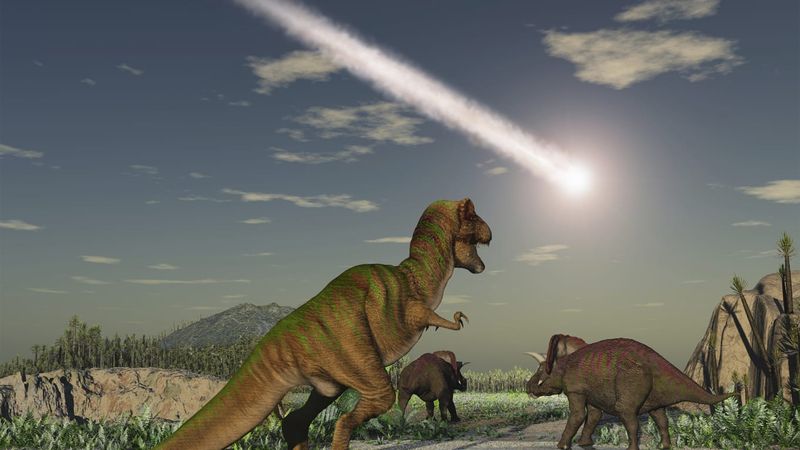Mass extinction
A mass extinction is defined as an event where 75% or more of the species on Earth went extinct. [1] The extinction of the dinosaurs at the end of the Cretaceous period, 65 million years ago, is the most well-known of these events. However, throughout the Earth's history, there have been five mass extinction events, listed below. Many scientists also believe that a sixth event is currently occurring, caused by anthropogenic forces, and happening at a much faster rate than any previous extinction event.
Throughout all of Earth's history, species have been going extinct. The regular rate at which species go extinct and are replaced is known as the background extinction rate. Mass extinction events happen when there's a significant increase in the extinction rate. Scientists believe that all five previous mass extinction events listed below are caused by rapid climate change.[2] In these instances, organisms that are not able to adapt quickly enough to changes in their environment, go extinct.

Ordovician-Silurian Extinction
The first mass extinction in the fossil record occurred at the end of the Ordovician period, about 440 million years ago, and eliminated roughly 86% of all living beings at that time. [4] At this time, the planet was covered in plants, which may have captured so much carbon dioxide from the air that it cooled the planet and resulted in glaciation. Also, the formation of mountain ranges may have resulted in sea levels falling. Since the majority of species lived in the oceans at this time, the combination of these two changes in their environment wiped out nearly all life on Earth.
Late Devonian Extinction
The second mass extinction occurred at the end of the Devonian period, about 364 million years ago, and roughly 75% of all life on Earth went extinct. While the other 4 mass extinctions are thought to have occurred on a restricted timeline, geologically speaking, it is unclear whether the late Devonian shares this characteristic or not. Since it is unclear how long it took for this event to occur, it is also unclear what caused it. Scientists have proposed ideas such as: asteroids, plate tectonics, sea level changes, and plants causing eutrophication, to explain the late Devonian extinction. Ammonites and trilobites are two examples of organisms which were eliminated during this event.
Permian-Triassic Extinction
The third and (so far) largest of all the mass extinction events in Earth's history happened at the end of the Permian period, about 251 million years ago. This event is often known as "The Great Dying", because 96% of all species on the planet went extinct.[5] Potential explanations for what caused this event include volcanic eruptions, asteroids, and climate change from methane.
Late Triassic Extinction
The fourth extinction event happened at the end of the Triassic period, around 200 million years ago, and eliminated about 76% of all species alive. Scientists believe that volcanic eruptions and asteroid impacts led to insurmountable climate change, to which species could not adapt. Prior to this event, mammals were the dominant group on Earth, outnumbering early dinosaurs. After this event, mammals were significantly reduced, and dinosaurs reigned. Some examples of dinosaurs which existed during the Triassic period are Procompsognathus, and Melanorosaurus.
Late Cretaceous Extinction
The fifth, and most famous of all mass extinction events occurred 65 million years ago, at the end of the Cretaceous period. As was the case with the late Triassic extinction, 76% of all species went extinct, including all dinosaurs. Once again, volcanic eruptions and asteroid impacts are thought to have caused the climate and environment to change too fast for dinosaurs to adapt. The Chicxulub crater in Yucatan, Mexico is said to be the place where a 10 km in diameter asteroid impacted the Earth and threw an enormous amount of dust and debris into the atmosphere causing sun blotting and ultimately global cooling. The end of the era of dinosaurs allowed for mammals to flourish once more.
Sixth Extinction?
Many scientists believe that the Earth is currently undergoing a time of mass extinction.[6] Unlike all previous events, there are no enormous volcanic eruptions spewing layers of molten ash over the planet, there are no massive asteroids bombarding the Earth. The "sixth extinction" is thought to be completely caused by humans. Human impacts on organisms include overhunting, deforestation, rising sea levels, ocean acidification, [Habitat range change|habitat loss]], pollution, invasive species, and of course, climate change.
The human impacts listed above can affect animals in many ways. Loss and disruption of habitats, loss of food sources, changing ecosystems, increasing competition from invasive species, and disease are all contributing to this sixth mass extinction.
Areas of highest biodiversity have been hit the hardest. Tropical rainforests and coral reefs are experiencing significant loss in biodiversity, most of which goes unnoticed. While it may have taken several hundred thousand years for the trilobytes to go extinct, it is now very likely that once prosperous species will go extinct within 1 human lifetime.
For Further Reading
- High energy society
- Climate forcing
- Indicators of a warming world
- Renewable and sustainable energy
- Or explore a random page
References
- ↑ Retrieved from https://cosmosmagazine.com/palaeontology/big-five-extinctions
- ↑ Retrieved from https://cosmosmagazine.com/palaeontology/big-five-extinctions accessed February 20th, 2020.
- ↑ Retrieved from https://www.thedailybeast.com/the-sixth-mass-extinction-we-arent-the-dinosaurs-were-the-asteroid
- ↑ https://www.britannica.com/science/Ordovician-Silurian-extinction
- ↑ Retrieved from https://www.worldatlas.com/articles/the-timeline-of-the-mass-extinction-events-on-earth.html
- ↑ Kolbert, Elizabeth. (2014) The sixth extinction :an unnatural history London : Bloomsbury

